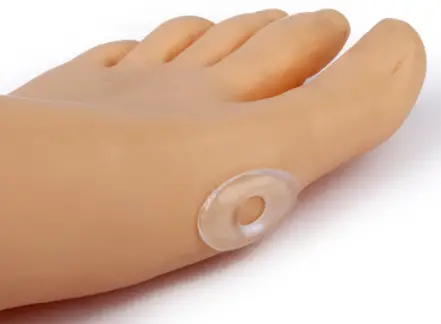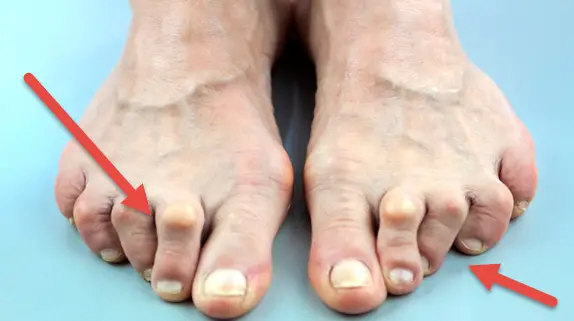What Does Corns On Feet Look Like?
Contents
What are “corns”?
“Corns” is a commonly used term for painful bumps or lumps on the foot or toe. Many times used in error, “corns” are accurately used to describe a thickening of skin over an area of irritation on a toe. Just as we develop a thickening of our skin on the palms of our hands after performing a repetitive movement over a period of time, the same bodily reaction occurs when outside pressure on a boney prominence on one, or more, of our toes. The word “corns” describe this skin thickening on a toe, and only toes, as compared to the thickening of the skin of the bottom or side of the foot, which are referred to as “calluses”. Discoloration of the skin on a toe, without any thickening, cannot necessarily be referred to as corns.
Causes of Corn on Foot
The key to understanding what “corns” are is to understand the causes that produce a corn. Without pressure from a tight shoe, improper foot function, or some other exterior irritation, “corns” will not occur. However, if a “hammer toe” deformity is present, it is almost impossible to prevent corns. In most cases, a corn results from a structural contraction of the toe, that causes pressure from shoes, socks, or foot function that initiates a reaction from the body to form a “keratosis” over the pressure point. This keratosis is an attempt by the body to protect the area of bone from this abnormal pressure. Simply put, “corns” are a protective response of the body in an attempt to cushion the area of bone that is getting too much pressure. The word “keratosis” is medical terminology for a hardening of the skin, anywhere on the body.
How To Get Rid of a Corn
Treatments for corns consist of removing pressure from the area of bone that is irritated. Removing pressure from the area, with a pad, wider shoe, or band-aid are commonly used conservative, over- the counter treatments for a corn. If the irritation was the result of a one-time incident, these conservative methods should be successful. If the cause is a structural foot problem or deformity, simple pressure reducing treatments are usually unsuccessful.
Many self-applied “corn pads” contain a very powerful acid. The acid is used to burn away the hard skin, therefore reducing pressure and pain from the irritated area. This may be acceptable in some instances, but with patients with compromised health, such as vascular disease, neuropathy, or diabetes, should not use this type of treatment I due to the possibility of tissue injury and subsequent infection.

In most cases, corns are secondary to a hammertoe deformity. The toe is abnormally contracted, which causes a rigid deformity of the knuckle of the toe and a prominent pressure point on the toe. Any irritation from a shoe or sock on this knuckle will cause a blister and subsequent corn to form on the toe. The best treatment for this problem is a surgical correction of the hammer toe. Other treatments may give temporary relief, but if the deformity continues, so will the corns.

Conservative treatment with pads, acid therapy, and wider or longer shoes may give temporary relief. Seeing your Podiatrist to remove the corn by shaving off the hard skin will also give temporary relief. However, it is important that one realizes what is causing their corn problem, and what can be done to give you temporary or permanent relief of your symptoms; long-lasting relief usually requires surgical correction.
Prevention of Corns
It is far easier to prevent corns and calluses from ever developing than to get rid of them once they form. Some calluses, such as the ones on the balls and heel of the feet are unavoidable unless you spend absolutely no time on your feet. To prevent other calluses and corns from appearing, focus on reducing the amount of friction on your feet and ease the pressure on the common hotspots such as the toes and the base of the feet. This typically involves extra padding, and reducing the time spent in narrow and restrictive shoes, and in particular, high heels.
If you notice an area of the foot is becoming callused or if a blister develops, take note of what shoes you were wearing or what activities you participated in. Make changes based on these observations before a blister or patch of rough skin turns in to a full-fledged callus or corn. A blister can be seen as an early warning signal that a corn or callus will form.
Wear shoes that fit your feet comfortably without causing any irritation, or without placing too much pressure on specific areas of the feet. Tight shoes are the most common cause of calluses and corns, as the pressure from the shoe rubbing against the skin is what causes calluses and corns to form in most cases. If your shoes are too big, the feet may move around too much inside the shoe causing friction. On the other hand, if the shoes are tight, the pressure will cause these patches of dry, hardened and dead skin to form.
Placing padding in the shoe or on the foot in areas where high pressure is exerted can prevent excessive friction. It can be difficult to determine where to place padding prior to the appearance of a callus or corn, but if you feel rubbing from the shoe, this is generally a good place to put the padding. Thick socks can also act as padding for the entire foot, and are a good choice, especially if a lot of walking is to be expected. With thick socks, it is important that there is no slouching of the socks in the shoe, as the pressure from a bump in the sock can be enough to cause a callus or corn to form.
Additionally, if socks with toe seams irritate your feet, change to a sock without a seam or try turning the sock inside out. There are specialist five-toed socks on the market which are an excellent choice, although choose only high-quality brands such s Injinji. Any brand designed specifically for wear with five-toed shoes, such as Vibram Lizard socks are also a great choice. Socks made specifically for walkers and hikers are likewise a good choice. They are more expensive, but the cost is often worthwhile.
Run your fingers along the entire inner portion of a shoe to feel for parts of the shoe that might jam into your foot. Common areas where this may occur are under the eyelets or tongue of the shoe, where the insole attaches to the upper, in the toe bed, and at the seam in the back of the shoe. If you feel anything protruding, either place padding to protect the foot from this area or choose a different pair of shoes. Each shoe is made differently, so you may be able to find the same shoe without these defects.
If the rough skin from a developing callus does not seem to be footwear related, a biomechanical defect in your foot may be the cause, such as fallen arches, bunions or bone abnormalities. Treating the underlying condition will help prevent calluses and corns from developing, and is the best way of prevention. Another possibility is that certain activity causes wear on your feet in new or different areas. Ballet dancers who stand on their toes often develop calluses on the tips of their toes. While you can try to use the above prevention methods, if the activity is one you enjoy and the calluses do not cause discomfort, consider allowing the calluses to develop as this will protect your skin.
What Does Corns On Feet Look Like? Last Updated: 11/12/2017



Pingback: What Causes a Corn on Foot? Unknown 5 Causes - Body Pain Tips